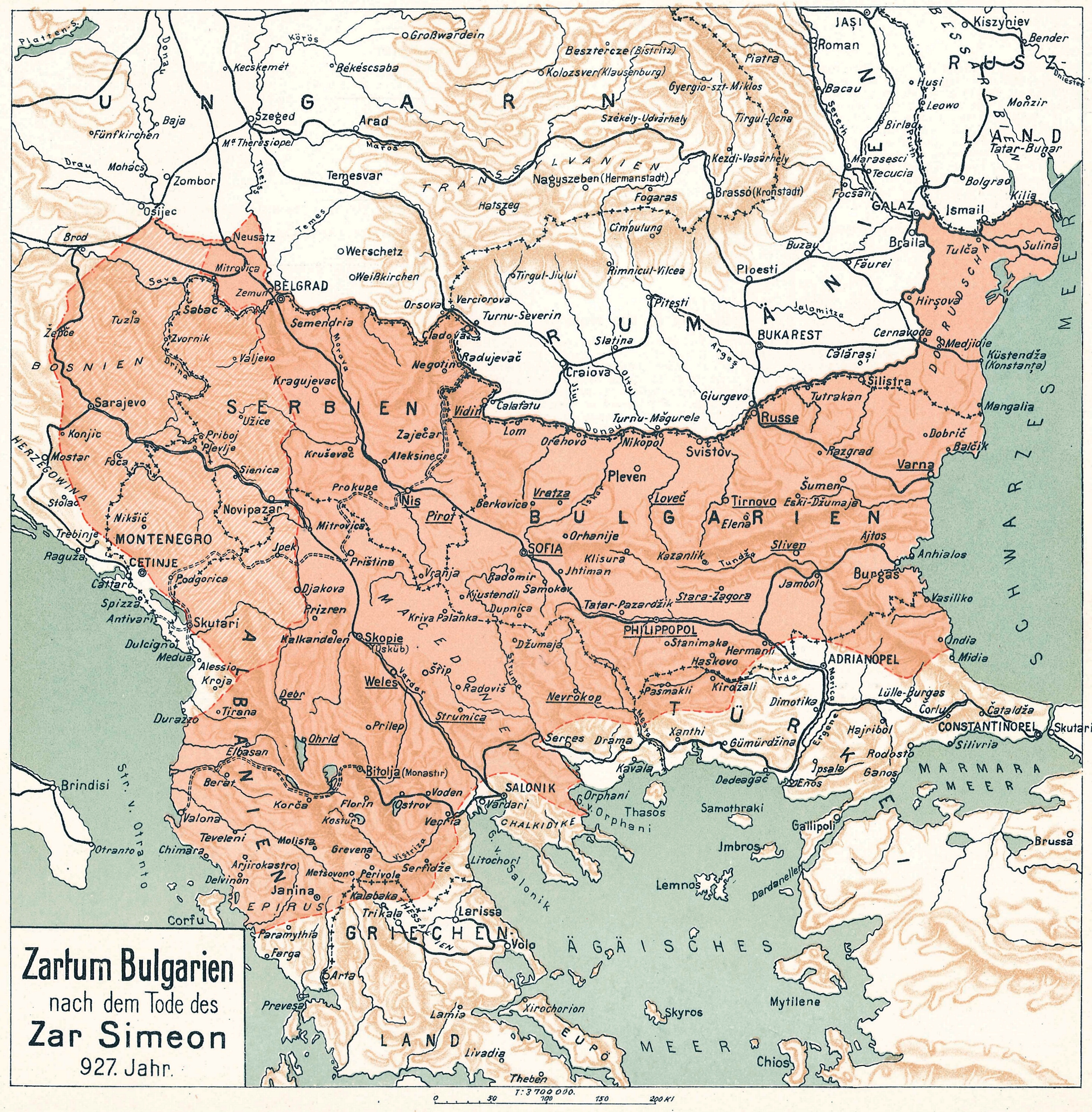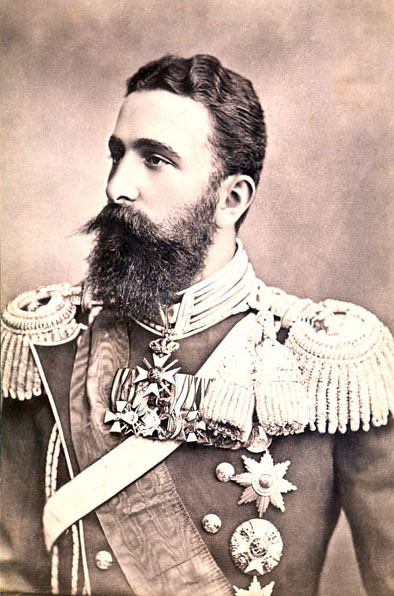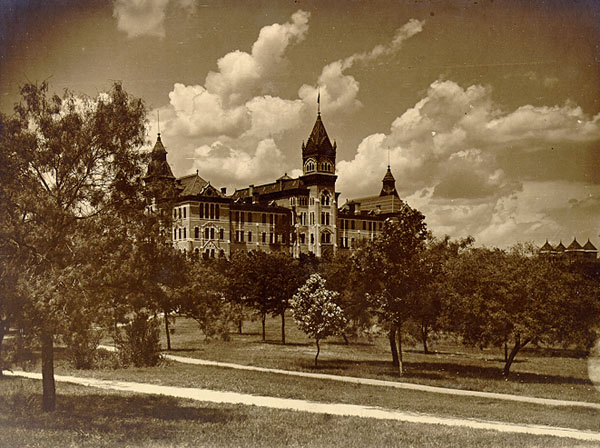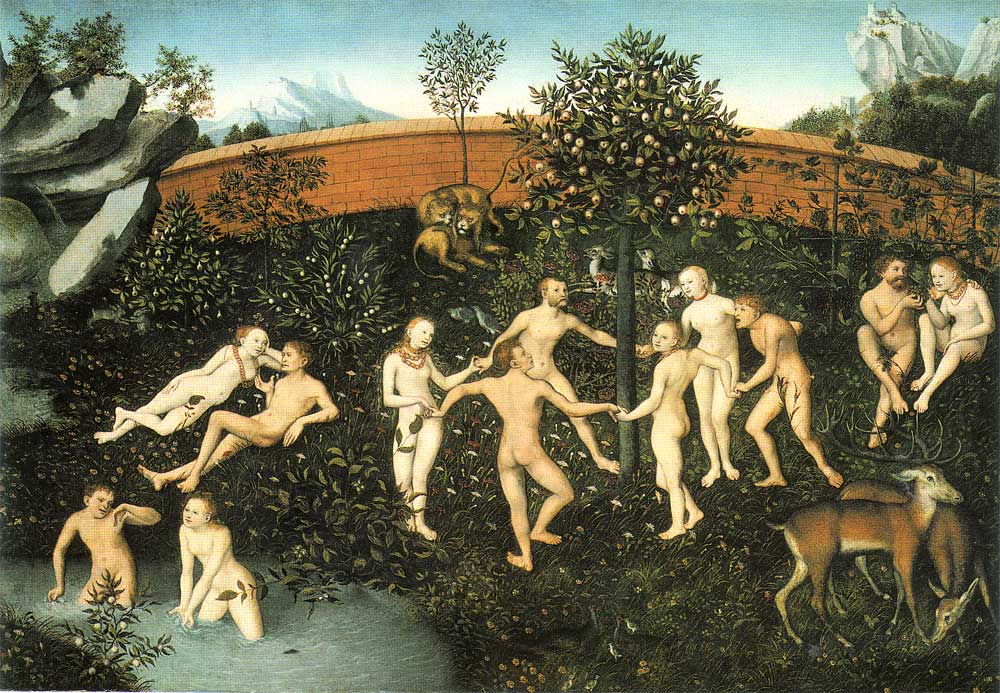|
Simeon The Great
Simeon I the Great (; ; ) ruled over Bulgaria from 893 to 927,Lalkov, ''Rulers of Bulgaria'', pp. 23–25. during the First Bulgarian Empire. Simeon's successful campaigns against the Byzantines, Magyars and Serbs led Bulgaria to its greatest territorial expansion ever, making it the most powerful state in contemporary Eastern and Southeast Europe. His reign was also a period of unmatched cultural prosperity and enlightenment later deemed the Golden Age of Bulgarian culture. During Simeon's rule, Bulgaria spread over a territory between the Aegean, the Adriatic and the Black seas.Bakalov, ''Istorija na Bǎlgarija'', "Simeon I Veliki". The newly independent Bulgarian Orthodox Church became the first new patriarchate besides the Pentarchy, and Bulgarian Glagolitic and Cyrillic translations of Christian texts spread all over the Slavic world of the time. It was at the Preslav Literary School in the 890s that the Cyrillic alphabet was developed. [...More Info...] [...Related Items...] OR: [Wikipedia] [Google] [Baidu] |
List Of Bulgarian Monarchs
The monarchs of Bulgaria ruled Bulgaria during the medieval First ( 681–1018) and Second (1185–1422) Bulgarian empires, as well as during the modern Principality (1879–1908) and Kingdom (1908–1946) of Bulgaria. This list includes monarchs from the establishment of the First Bulgarian Empire until modern times, omitting earlier mythical rulers as well as rulers of separate states such as Old Great Bulgaria and Volga Bulgaria. Various titles have been used by the rulers of Bulgaria. The only recorded title, used before Bulgaria's conversion to Christianity, is '' kanasubigi'', likely meaning " Khan, Lord of the Army" or "the sublime Khan". When Bulgaria converted to Christianity in the ninth century, the ruler Boris I (852–889) was using the title ''knyaz'' (prince). For much of its later history under the first and second empires, Bulgaria functioned as a multi-ethnic imperial state modelled on the neighbouring Byzantine Empire, which contributed to the adoption of th ... [...More Info...] [...Related Items...] OR: [Wikipedia] [Google] [Baidu] |
Principality Of Serbia (early Medieval)
Principality of Serbia (Modern sr-Cyrl-Latn, Кнежевина Србија, Kneževina Srbija, separator=" / "; also known as Principality of Serbs, (Modern sr-Cyrl-Latn, Кнежевина Срба, Kneževina Srba, separator=" / "; ; ) was one of the early medieval states of the Serbs, located in the western regions of Southeastern Europe. It existed from the 8th century up to c. 969–971 and was ruled by the Vlastimirović dynasty. Its first ruler known by name was Višeslav who started ruling around 780. While by that time, starting from the year 680–681, the Bulgarian state had taken the lands to the east. Vlastimir resisted and defeated the Bulgarian army in a three-year-war (839–842), and the two powers lived in peace for some decades. Vlastimir's three sons succeeded in ruling Serbia together, although not for long; Serbia became a key part in the power struggle between the Byzantines and Bulgarians, predominantly allied with the Byzantines, which also resulte ... [...More Info...] [...Related Items...] OR: [Wikipedia] [Google] [Baidu] |
Pentarchy
Pentarchy (, ) was a model of Church organization formulated in the laws of Emperor Justinian I () of the Roman Empire. In this model, the Christian Church is governed by the heads (patriarchs) of the five major episcopal sees of the Roman Empire: Rome, Constantinople, Alexandria, Antioch, and Jerusalem. The idea came about because of the political and ecclesiastical prominence of these five sees, but the concept of their universal and exclusive authority was attached to earlier Hellenistic-Christian ideas of administration. The pentarchy was first legally expressed in the legislation of Emperor Justinian I, particularly in ''Novella'' 131. The Quinisext Council of 692 gave it formal recognition and ranked the sees in order of preeminence, but its organization remained dependent on the emperor, as when Leo the Isaurian altered the boundary of patriarchal jurisdiction between Rome and Constantinople. Especially following Quinisext, the pentarchy was at least philosophically a ... [...More Info...] [...Related Items...] OR: [Wikipedia] [Google] [Baidu] |
Patriarchate
Patriarchate (, ; , ''patriarcheîon'') is an ecclesiological term in Christianity, referring to the office and jurisdiction of a patriarch. According to Christian tradition, three patriarchates—Rome, Antioch, and Alexandria—were established by the apostles as apostolic sees in the 1st century. These were officially recognized by the First Council of Nicaea. The Patriarchate of Constantinople was added in the 4th century, and the Patriarchate of Jerusalem followed in the 5th century. These five sees were later recognized collectively as the pentarchy by the Council of Chalcedon in 451. Over the course of Christian history, additional patriarchates were gradually recognized by the original ancient episcopal sees. However, several of these later lost jurisdiction—primarily due to the Islamic conquests in the Middle East and North Africa—and became titular or honorary patriarchates without real institutional authority over their historical territories. Histo ... [...More Info...] [...Related Items...] OR: [Wikipedia] [Google] [Baidu] |
Bulgarian Orthodox Church
The Bulgarian Orthodox Church (), legally the Patriarchate of Bulgaria (), is an autocephalous Eastern Orthodox Church, Eastern Orthodox jurisdiction based in Bulgaria. It is the first medieval recognised patriarchate outside the Pentarchy and the Christianization of the Slavs, oldest Slavic Orthodox church, with some 6 million members in Bulgaria and between 1.5 and 2 million members in a number of other European countries, Asia, the Americas, Australia, and New Zealand. It was recognized as autocephalous in 1945 by the Ecumenical Patriarchate of Constantinople. History Early Christianity The Bulgarian Orthodox Church has its origin in the flourishing Christian communities and churches established in Southeast Europe as early as the first centuries of the Christian era. Christianity was brought to the Thracians, Thracian lands by the apostles Apostle Paul, Paul and Apostle Andrew, Andrew in the 1st century AD, when the first organised Christian communities were formed. By ... [...More Info...] [...Related Items...] OR: [Wikipedia] [Google] [Baidu] |
Leipzig
Leipzig (, ; ; Upper Saxon: ; ) is the most populous city in the States of Germany, German state of Saxony. The city has a population of 628,718 inhabitants as of 2023. It is the List of cities in Germany by population, eighth-largest city in Germany and is part of the Central German Metropolitan Region. The name of the city is usually interpreted as a Slavic term meaning ''place of linden trees'', in line with many other Slavic placenames in the region. Leipzig is located about southwest of Berlin, in the southernmost part of the North German Plain (the Leipzig Bay), at the confluence of the White Elster and its tributaries Pleiße and Parthe. The Leipzig Riverside Forest, Europe's largest intra-city riparian forest, has developed along these rivers. Leipzig is at the centre of Neuseenland (''new lake district''). This district has Bodies of water in Leipzig, several artificial lakes created from former lignite Open-pit_mining, open-pit mines. Leipzig has been a trade city s ... [...More Info...] [...Related Items...] OR: [Wikipedia] [Google] [Baidu] |
Black Sea
The Black Sea is a marginal sea, marginal Mediterranean sea (oceanography), mediterranean sea lying between Europe and Asia, east of the Balkans, south of the East European Plain, west of the Caucasus, and north of Anatolia. It is bounded by Bulgaria, Georgia (country), Georgia, Romania, Russia, Turkey, and Ukraine. The Black Sea is Inflow (hydrology), supplied by major rivers, principally the Danube, Dnieper and Dniester. Consequently, while six countries have a coastline on the sea, its drainage basin includes parts of 24 countries in Europe. The Black Sea, not including the Sea of Azov, covers , has a maximum depth of , and a volume of . Most of its coasts ascend rapidly. These rises are the Pontic Mountains to the south, bar the southwest-facing peninsulas, the Caucasus Mountains to the east, and the Crimean Mountains to the mid-north. In the west, the coast is generally small floodplains below foothills such as the Strandzha; Cape Emine, a dwindling of the east end ... [...More Info...] [...Related Items...] OR: [Wikipedia] [Google] [Baidu] |
Adriatic Sea
The Adriatic Sea () is a body of water separating the Italian Peninsula from the Balkans, Balkan Peninsula. The Adriatic is the northernmost arm of the Mediterranean Sea, extending from the Strait of Otranto (where it connects to the Ionian Sea) to the northwest and the Po Valley. The countries with coasts on the Adriatic are Albania, Bosnia and Herzegovina, Croatia, Italy, Montenegro, and Slovenia. The Adriatic contains more than 1,300 islands, mostly located along its eastern coast. It is divided into three basins, the northern being the shallowest and the southern being the deepest, with a maximum depth of . The prevailing currents flow counterclockwise from the Strait of Otranto. Tidal movements in the Adriatic are slight, although acqua alta, larger amplitudes occur occasionally. The Adriatic's salinity is lower than the Mediterranean's because it collects a third of the fresh water flowing into the Mediterranean, acting as a dilution basin. The surface water temperatures ... [...More Info...] [...Related Items...] OR: [Wikipedia] [Google] [Baidu] |
Aegean Sea
The Aegean Sea is an elongated embayment of the Mediterranean Sea between Europe and Asia. It is located between the Balkans and Anatolia, and covers an area of some . In the north, the Aegean is connected to the Marmara Sea, which in turn connects to the Black Sea, by the straits of the Dardanelles and the Bosphorus, respectively. The Aegean Islands are located within the sea and some bound it on its southern periphery, including Crete and Rhodes. The sea reaches a maximum depth of 2,639 m (8,658 ft) to the west of Karpathos. The Thracian Sea and the Sea of Crete are main subdivisions of the Aegean Sea. The Aegean Islands can be divided into several island groups, including the Dodecanese, the Cyclades, the Sporades, the Saronic Islands, Saronic islands and the North Aegean islands, North Aegean Islands, as well as Crete and its surrounding islands. The Dodecanese, located to the southeast, includes the islands of Rhodes, Kos, and Patmos; the islands of Delos and Naxos are wi ... [...More Info...] [...Related Items...] OR: [Wikipedia] [Google] [Baidu] |
University Of Texas At Austin
The University of Texas at Austin (UT Austin, UT, or Texas) is a public university, public research university in Austin, Texas, United States. Founded in 1883, it is the flagship institution of the University of Texas System. With 53,082 students as of fall 2023, it is also the largest institution in the system. The university is a major center for academic research, with research expenditures totaling $1.06 billion for the 2023 fiscal year. It joined the Association of American Universities in 1929. The university houses seven museums and seventeen libraries, including the Lyndon Baines Johnson Library and Museum, Lyndon B. Johnson Presidential Library and the Blanton Museum of Art, and operates various auxiliary research facilities, such as the J. J. Pickle Research Campus and McDonald Observatory. UT Austin's athletics constitute the Texas Longhorns. The Longhorns have won four NCAA Division I National Football Championships, six NCAA Division I National Baseball Champions ... [...More Info...] [...Related Items...] OR: [Wikipedia] [Google] [Baidu] |
Bulgarian Culture
A number of ancient civilizations, including the Thracians, ancient Greeks, Scythians, Celts, ancient Romans, Goths (Ostrogoths and Visigoths), Slavs (East Slavs, East and West Slavs), Varangians and the Bulgars have left their mark on the culture, history and heritage of Bulgaria. Due to this great variety of influences, Bulgaria has adopted many unusual traditions. Thracian artifacts include numerous temples, tombs, Thracian treasure, golden treasures and ancient rites and rituals, while the Bulgars have left traces of their heritage in statehood, early architecture, music and dances. Thracian rituals such as the Tryphon Zarezan which is dedicated to Saint Tryphon of Campsada, Kukeri and Martenitsa are to this day kept alive in the modern Bulgarian culture. The oldest treasure of worked gold in the world, dating back to the 5th millennium BC, comes from the site of the Varna Necropolis. Bulgaria functioned as a cultural hub of Slavic Europe during much of the Middle Ages ... [...More Info...] [...Related Items...] OR: [Wikipedia] [Google] [Baidu] |
Golden Age (metaphor)
A golden age is a period considered the peak in the history of a country or people, a time period when the greatness, greatest achievements were made. The term originated from early ancient Greece, Greek and ancient Rome, Roman poets, who used it to refer to a time when mankind lived in a better time and was pure (see Golden Age). The ancient Greek poet Hesiod introduced the term in his ''Works and Days'', when referring to the period when the "Golden Race" of man lived. This was part of fivefold division of Ages of Man, starting with the Golden age, then the Silver Age, the Bronze Age, the Greek Heroic Age, Age of Heroes (including the Trojan War), and finally, the current Iron Age. The concept was further refined by Ovid, in his ''Metamorphoses'', into the four "metal ages" (golden, silver, bronze, and iron). The Golden age in Classic literature The Golden age as described by Hesiod was an age where all humans were created directly by the Olympian gods. They lived long lives ... [...More Info...] [...Related Items...] OR: [Wikipedia] [Google] [Baidu] |








